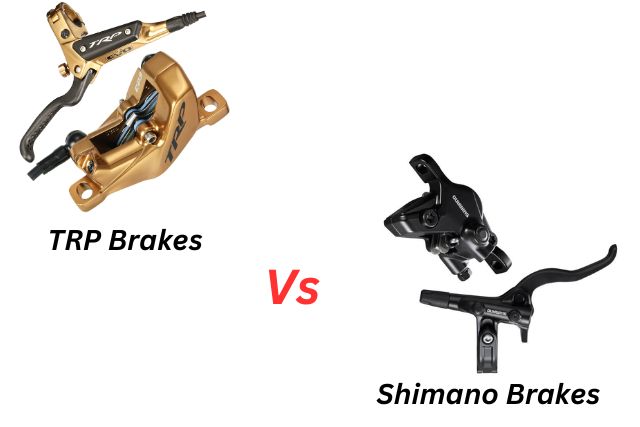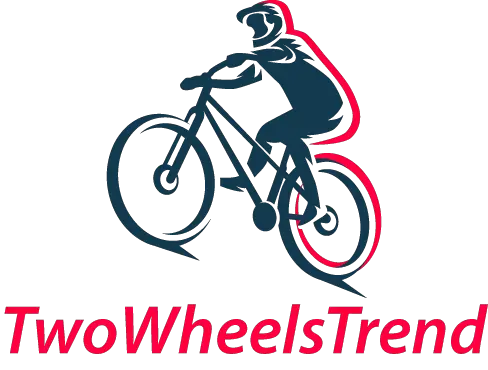
TRP and Shimano, both brands offer high-quality products that are designed for different riding styles and preferences.
Below, we will compare TRP and Shimano brakes in terms of power, modulation, reliability, maintenance, and price. You’ll also get some tips on how to choose the best brakes for your bike.
Power
Power is the ability of a brake to stop your bike quickly and effectively. Power depends on many factors, such as the size and shape of the brake caliper, the number and material of the brake pistons, the type and size of the brake rotor, the type and compound of the brake pads, and the quality of the brake fluid.
TRP Brakes
TRP brakes are known for their high power output, especially in their four-piston models such as the G-Spec Quadiem and the DH-R EVO. These brakes use hybrid ceramic-steel pistons that reduce heat buildup and improve braking performance.
TRP brakes have large cooling fins on the calipers and rotors that help dissipate heat and prevent brake fade. It uses mineral oil as their brake fluid, which is less corrosive and easier to bleed than DOT fluid.
Shimano Brakes
Shimano brakes are also very powerful, especially in their Saint and Zee models that are designed for downhill and enduro riding. It uses four ceramic pistons that provide consistent braking power and modulation.
Shimano brakes also have cooling fins on the calipers, rotors, and pads that help reduce heat and improve durability. These brakes use mineral oil as their brake fluid as well.
Related: Is Shimano Tourney TX Good?
Brake Compatibility
Both TRP and Shimano brakes are compatible with each other’s pads and rotors, so you can mix and match them to suit your preferences. However, some riders prefer to use the same brand of pads and rotors as their brakes to ensure optimal performance.
Modulation
It refers to a brake’s capacity to precisely regulate the level of braking force exerted on the wheel. Modulation depends on factors such as the design of the brake lever, the length of the brake hose, the stiffness of the brake system, and the personal preference of the rider.
TRP Brakes
TRP brakes are known for their excellent modulation, especially in their two-piston models such as the Slate T4 and the Spyre. These brakes have a smooth and progressive feel that allows you to fine-tune your braking power with minimal finger effort.
TRP brakes also have tool-free reach and bite point adjustments that let you customize your lever position and feel.
Shimano Brakes
These brakes are known for their crisp and responsive feel, especially in their XT and XTR models that are designed for cross-country and trail riding. Shimano brakes have a short lever stroke and a firm bite point that gives you instant feedback and confidence.
Shimano brakes also have tool-free reach adjustment and free stroke adjustment that let you adjust your lever position and feel.
Modulation Differences and Rider Preferences
TRP and Shimano brakes have good modulation, but they have different characteristics that appeal to different riders. Some riders prefer the soft and smooth feel of TRP brakes, while others prefer the sharp and snappy feel of Shimano brakes.
Read Also: What is Shimano Parallax?
Reliability
It is all about having a brake that consistently and dependably works well in different conditions.
Reliability depends on factors such as the quality of the materials, the precision of the manufacturing, the ease of maintenance, and the availability of spare parts.
TRP Brakes
TRP brakes are relatively new in the market compared to Shimano brakes, but they have proven to be reliable in terms of performance and durability. These brakes are made with high-quality materials such as forged aluminum, stainless steel, titanium, carbon fiber, etc.
TRP brakes are also easy to maintain with simple bleeding procedures and standard tools. They have a growing network of dealers and distributors around the world that can provide spare parts and service.
Shimano Brakes
These brakes are well-established in the market with a long history of innovation and excellence. Shimano Brakes are made with high-quality materials such as forged aluminum, magnesium, titanium, carbon fiber, etc.
These brakes are known for their user-friendly maintenance, with straightforward bleeding procedures and compatibility with standard tools. Furthermore, Shimano brakes have a strong global network of dealers and distributors, ensuring convenient access to spare parts and reliable service no matter where you are.
Common Brake Issues and Problems (TRP and Shimano)
Both TRP and Shimano brakes are reliable in terms of performance and durability, but they may have different issues or problems depending on your riding style and conditions.
Some common issues or problems that may affect your brakes are:
Brake squeal
This is a loud noise that occurs when your brake pads vibrate against your rotors due to contamination or misalignment.
To prevent this issue, follow these steps:
- Clean your pads and rotors regularly using alcohol or brake cleaner.
- Properly align your calipers with your rotors.
- Use anti-squeal compound or shims on your pads.
- Bed in your brakes properly.
Brake fade
It is a loss of braking power that occurs when your brake system overheats due to excessive or prolonged braking.
To fix this issue, you have to use larger or vented rotors, use metallic or finned pads, use fresh and high-quality brake fluid, and avoid dragging your brakes unnecessarily.
To fix this issue, consider the following steps:
- Use larger or vented rotors.
- Switch to metallic or finned brake pads.
- Utilize fresh and high-quality brake fluid.
- Avoid unnecessarily dragging your brakes.
Brake rub
It is a friction that occurs when your brake pads touch your rotors slightly due to wear or deformation. To prevent or fix this issue:
- Check pad wear and replace them when needed.
- Inspect rotor straightness and true them if necessary.
- Verify caliper alignment and adjust if needed.
- Examine wheel bearings and hub spacing, and tighten them if necessary.
Related: What is Shimano Ice Tech?
Price
TRP Brakes
TRP brakes are generally cheaper than Shimano brakes, especially in their four-piston models.
For example, the TRP G-Spec Quadiem brake set costs around $300 USD, while the Shimano Saint brake set costs around $400 USD. The TRP Quadiem brake set costs around $200 USD, while the Shimano Zee brake set costs around $250 USD.
The TRP Slate T4 brake set costs around $180 USD, while the Shimano XT brake set costs around $230 USD.
Shimano Brakes
Shimano brakes are expensive than TRP brakes, especially in their two-piston models.
For example, the Shimano XTR brake set costs around $500 USD, while the TRP Spyre brake set costs around $150 USD. The Shimano SLX brake set costs around $150 USD, whereas the TRP Spyke brake set costs around $100 USD.
How to choose the best brakes for your bike?
Choosing the best brakes for your bike depends on many factors, such as your riding style, terrain, bike type, personal preference, etc.
Here are some general tips on how to choose the best brakes for your bike:
Consider your Riding Style
If you ride downhill or enduro, you need powerful and reliable brakes that can handle steep and rough terrain. You should look for four-piston brakes with large rotors and metallic pads.
If you ride cross-country or trail, you need light and efficient brakes that can provide good modulation and control. You should look for two-piston brakes with medium rotors and resin pads.
Consider your Bike Type
For full-suspension bikes, it’s essential to have brakes that can adapt to the suspension’s movement and avoid any interference with the frame or linkage. Look for brakes equipped with adjustable banjo fittings or hose routing options to ensure a seamless fit.
On the other hand, if you have a hardtail bike, brakes that can absorb trail vibrations and shocks are crucial. Opt for brakes featuring rubberized or ergonomic lever blades or grips for enhanced comfort and control.
